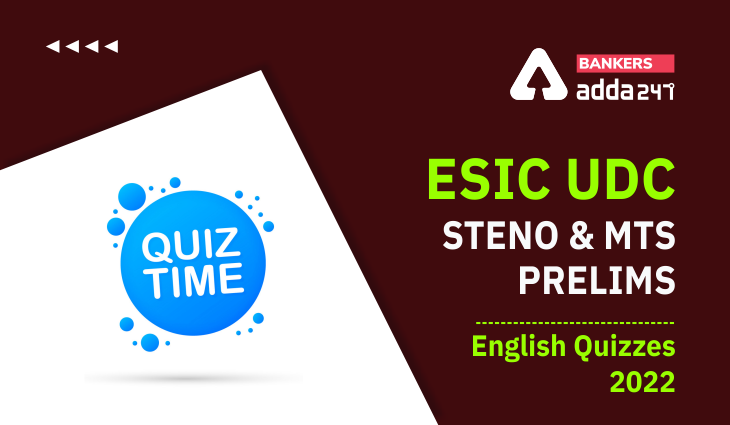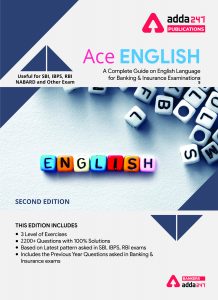Directions (1-15): In the following passage there are blanks, each of which has been numbered. These numbers are printed below the passage and against each, options are given. Find out the appropriate word which fits into the blank appropriately.
You may have heard it when flipping on a light, switching on your TV or walking near power lines — that unmistakable hum of electricity. But what, exactly, is that hum? And more importantly, is it ever a sign of danger? The ________1________ electricity makes is known as the “mains hum,” and it happens because of the way electricity is produced. The electricity that comes from power plants uses alternating current (AC), so named because the current changes ________2________, or alternates, many times per second.
The number of times per second the current alternates depend on the standard of the __________3_________ country. In places such as the United States, Canada and several Central and South American countries, AC power ________4_______ at 60 hertz, or 60 times per second. In much of the rest of the world, it alternates at 50 hertz, or 50 times per second. The hum you hear is usually about twice the ________5__________ of the AC power being used, according to Gary Woods, a professor in the practice in the electrical and computer and engineering _________6________ at Rice University in Texas. That means that in the U.S., electricity hums at 120 hertz, or between a B and B-flat two octaves below middle C. In Europe, it hums at 100 hertz, or between an A-flat and G two octaves below middle C.
But what, exactly, is _______7_______ to create that hum? It’s usually a _________8_________ element inside the device. For example, when you’re near power lines, you might hear an electric hum coming from an electromagnetic device called a ________9_________, which is used to decrease the voltage of the power as it travels from the power plant to people’s homes, so the high ________10________ from the power plant doesn’t overload household electronics. “A transformer has an inductor inside it, which is just a magnetic element — it’s an electromagnet,” Woods said. “It’s a piece of iron that has a coil of wire wrapped around it. That’s inside every transformer.
“For reasons of ________11___________ engineering, you need to have an electromagnet inside the electronics to get the function that you want,” Woods added. “And so you can think of these magnetic elements as being like little magnets, and they’re being energized by the electric power. And so, they’re turning on and off [reversing their polarity] 60 times a second. So, they’re actually vibrating a little bit.”
The same thing happens in all sorts of electronics, from fluorescent bulbs to toaster ovens, Woods said. The reason power lines themselves might hum is due to a different ________12_______ called corona discharge. This hum, or discharge of energy, happens when the electrical field around the power lines is greater than what is needed to start a flow of electric current from the power line to the surrounding air. The _______13________ of that happening can depend on the weather, as water increases the conductivity of air. Most _______14_______ power lines are designed to avoid this problem, at least during dry conditions. If corona discharge does occur, it can be dangerous; there’s ________15_______ that corona discharge can produce toxic gases like ozone, which can harm human lungs if inhaled.
Q1.
(a) brook
(b) sound
(c) indication
(d) delicacy
(e) none of these
Q2.
(a) grove
(b) propriety
(c) commission
(d) direction
(e) none of these
Q3.
(a) particular
(b) conduct
(c) discreet
(d) ripple
(e) none of these
Q4.
(a) cultivates
(b) discord
(c) alternates
(d) perishes
(e) none of these
Q5.
(a) pinnacle
(b) reconsideration
(c) categorization
(d) frequency
(e) none of these
Q6.
(a) premise
(b) edifice
(c) department
(d) derivation
(e) none of these
Q7.
(a) vibrating
(b) reproaching
(c) computing
(d) alarming
(e) none of these
Q8.
(a) inconclusive
(b) magnetic
(c) callous
(d) deferential
(e) none of these
Q9.
(a) transformer
(b) analysis
(c) purchaser
(d) strategist
(e) none of these
Q10.
(a) unassisted
(b) normalcy
(c) amendment
(d) voltage
(e) none of these
Q11.
(a) psychological
(b) comprehensively
(c) electrical
(d) irreversibly
(e) none of these
Q12.
(a) prohibition
(b) submission
(c) transmit
(d) phenomenon
(e) none of these
Q13.
(a) likelihood
(b) discretionary
(c) expansive
(d) modification
(e) none of these
Q14.
(a) discretion
(b) endow
(c) modern
(d) imprecise
(e) none of these
Q15.
(a) scholarship
(b) siege
(c) evidence
(d) benefit
(e) none of these
Solutions
S1. Ans (b)
Sol. The only word which will fit the blank to make the sentence coherent is sound.
Brook: a small stream.
Delicacy: fineness or intricacy of texture or structure
S2. Ans (d)
Sol. The only word which will fit the blank to make the sentence coherent is direction
Grove: a small wood or other group of trees
S3. Ans (a)
Sol. The only word which will fit the blank to make the sentence coherent is particular.
Discreet: intentionally unobtrusive.
S4. Ans (c)
Sol. The only word which will fit the blank to make the sentence coherent is alternates.
Discord: disagreement between people.
Cultivate: prepare and use (land) for crops or gardening.
Perish: die, especially in a violent or sudden way.
S5. Ans (d)
Sol. The only word which will fit the blank to make the sentence coherent is frequency.
Pinnacle: the most successful point; the culmination
S6. Ans (c)
Sol. The only word which will fit the blank to make the sentence coherent is department.
Premise: base an argument, theory, or undertaking on
Edifice: a complex system of beliefs
S7. Ans (a)
Sol. The only word which will fit the blank to make the sentence coherent is vibrating
S8. Ans (b)
Sol. The only word which will fit the blank to make the sentence coherent is magnetic.
Callous: showing or having an insensitive and cruel disregard for others.
Inconclusive: not leading to a firm conclusion or result; not ending doubt or dispute.
Deferential: showing deference; respectful.
S9. Ans (a)
Sol. The only word which will fit the blank to make the sentence coherent is transformer.
Strategist: who makes strategy
S10. Ans (d)
Sol. The only word which will fit the blank to make the sentence coherent is voltage.
Normalcy: state of being normal
Amendment: a minor change or addition designed to improve a text, piece of legislation, etc.
S11. Ans (c)
Sol. The only word which will fit the blank to make the sentence coherent is electrical
Psychological: in a way that affects the mind or relates to the emotional state of a person
Comprehensibly: capable of being comprehended or understood; intelligible.
Irreversibly: in a way that cannot be undone or altered
S12. Ans (d)
Sol. The only word which will fit the blank to make the sentence coherent is phenomenon.
Prohibition: the act or practice of forbidding something by law
Submission: the action of accepting or yielding to a superior force
Transmit: to pass on by
Phenomenon: a fact or situation that is observed to exist or happen
S13. Ans (a)
Sol. The only word which will fit the blank to make the sentence coherent is likelihood.
Discretionary: available for use at the discretion of the user.
S14. Ans (c)
Sol. The only word which will fit the blank to make the sentence coherent is modern.
Discretion: he quality of behaving or speaking in such a way as to avoid causing offence or revealing confidential information.
Endow: provide with a quality, ability, or asset
S15. Ans (c)
Sol. The only word which will fit the blank to make the sentence coherent is evidence.
Siege: a military operation in which enemy forces surround a town or building





 English Language Quiz For Bank Foundatio...
English Language Quiz For Bank Foundatio...
 English Language Quiz For SBI Clerk Prel...
English Language Quiz For SBI Clerk Prel...
 English Language Quiz For SBI Clerk Prel...
English Language Quiz For SBI Clerk Prel...







